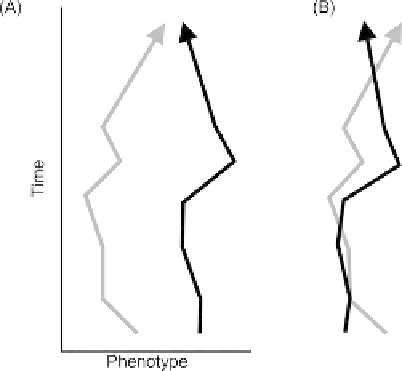Biology Reference
In-Depth Information
FIGURE 10.7
Comparing complex histories of pheno-
typic change by superimposition. (A) Two lineages exhibit
multiple changes in the direction of phenotypic evolution.
(B) Procrustes superimposition of the trajectories permits
visualization and quantification of differences between the
two trajectories.
MAGNITU
DE AND STRUCTURE OF MORPHOLOGICAL D
IVERSITY
Many of the questions we discussed in the previous sections are questions about the
generation and dispersion of morphological variation. In this section, we focus on methods
for quantifying the magnitude of morphological variation (also called disparity in interspe-
cific analyses).
Disparity and variation are closely allied concepts
both refer to the general idea of
“variety”. Disparity usually signifies the variety of a group of species and is the outcome
of evolutionary processes; variation, on the other hand, refers to the variety of individuals
within a single (homogeneous) population and is the raw material necessary for evolution.
Although there is a large and important theoretical distinction between disparity and vari-
ation, the metric (or formula) for measuring them is the same, and so we cover them both
here. Still, to avoid confounding concepts that have little in common aside from a metric,
we begin by reviewing their biological meanings, then turn to the issue of measurement.
Disparity
Disparity may be an unfamiliar term to many biologists, but it has emerged as a major
theme in the paleobiological literature. The term was introduced to clarify the distinction
between two notions of diversity that were often confounded: (1) phenotypic variety (often
but not always morphological), and (2) taxonomic richness. Due largely to work by Foote
(especially
Foote, 1990, 1993a, 1993b
), the distinction between them has been clarified
a
major step towards increasing both conceptual clarity and methodological rigor. In the
early literature, the number of taxa was often used as a measure of “disparity” but, as
Foote showed (1993b), and as many other studies have confirmed, the number of taxa
increases even as their morphological variety decreases.



